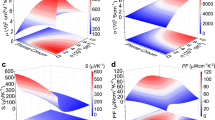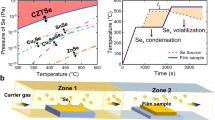Abstract
EXPERIMENTS have recently been made on the thermo-electric properties of selenium specimens of high purity (kindly supplied by Mr. T. R. Scott, of Standard Telecommunication Laboratories, Ltd.), with known amounts of residual contamination and sometimes with deliberate additives. Amorphous selenium was moulded into disks of 3 mm. thickness and 10 mm. diameter, and afterwards converted into the crystalline form by heat treatment. Gold electrodes were applied to the flat surfaces by vacuum evaporation. Various temperature differences were established between these surfaces, and the corresponding thermo-powers were determined, using nickel as a standard of reference.
This is a preview of subscription content, access via your institution
Access options
Subscribe to this journal
Receive 51 print issues and online access
$199.00 per year
only $3.90 per issue
Buy this article
- Purchase on SpringerLink
- Instant access to full article PDF
Prices may be subject to local taxes which are calculated during checkout
Similar content being viewed by others
References
Henisch, Elect. Comm., 25, 163 (1948).
Hochberg and Sominski, Phys. Z. d. Sowietunion, 13, 198 (1938).
Brown, Phys. Rev., 2, 153 (1913).
Author information
Authors and Affiliations
Rights and permissions
About this article
Cite this article
HENISCH, H., FRANÇOIS, M. Effect of Mercury on the Thermo-Electric Properties of Selenium. Nature 165, 891–892 (1950). https://doi.org/10.1038/165891a0
Issue date:
DOI: https://doi.org/10.1038/165891a0



